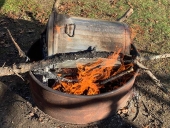I want to start a chestnut orchard, so listened to Tom Wahl's great, 2 hour video on starting a chestnut orchard,
https://www.youtube.com/watch?v=PAf1lUrqSq4&list=LL&index=69&t=2s&pp=gAQBiAQB in which he discusses picking less vigorous grasses as groundcovers to favor the chestnut trees above.
That made me think about when a man came to our Massachusetts Green Party's Boston chapter meeting and talked about grass seed. He introduced Pearl's Premium, a mix of slow-growing, deep-rooted varieties of lawn grasses that he envisioned could reduce mowing, need no fertilizer or chemicals and stay greener longer. Here's a short, hokey intro video:
https://www.youtube.com/watch?v=19-5N1H9dDQ. and here's their website:
https://www.pearlspremium.com
I hope to test Tom Wahl's seed mix and Pearl's Premium mix, as well as perennial lupins (L. perennis & L. polyphilus and any prostrate ones I can find), all under chestnuts, to see which works best for the trees, eases harvesting, and might be harvested (& ensiled?) as fodder.
What do you think?
Brian
-










